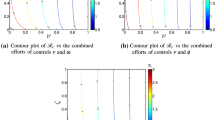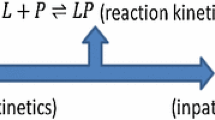Abstract
Illicit drug use (IDU) among students is now one of the increasingly major global public health issues. It can lead to students’ poor academic performance, physical and mental health issues, that in turn lead to poor development and productivity in their later life. The implementation of preventive and control measures for IDU carries a huge financial burden to the governments and the general public. Thus, the focus of this paper is to develop and analyse a non-linear optimal control problem based on an existing non-linear compartmental model of IDU dynamics in the student population with a view to providing insightful information to the government, decision and policy-makers about how to prioritise the implementations of public enlightenment policy, corrective measure and treatment control in terms of efficacy and cost benefits. The existing seven-dimensional deterministic model is modified to capture three time-dependent control variables denoting public enlightenment campaign, corrective measure and treatment. The non-linear optimal control model is rigorously analysed to explicitly prove the existence and characterize the optimal control triple using optimal control theory. Simulated results of the optimality system reveal that each of the single, double and triple interventions has positive impact in reducing the social crime of IDU. By carrying out the efficiency analysis on all the possible combinations of optimal controls, it is shown that implementing all the three optimal controls simultaneously are most efficient. Cost-effectiveness analysis indicates that the use of only public enlightenment policy is the single and overall most cost-effective strategy, while combination of only public enlightenment campaign and treatment is an alternative most cost-effective double intervention that may be adopted to prevent and control the menace of IDU with limited resources in the student population.




Similar content being viewed by others
Availability of data and materials
The author confirms that the data supporting the findings of this study are available within the article.
Code availability
Matlab code is available from the author on reasonable request.
References
Abidemi A, Akanni JO (2022) Dynamics of illicit drug use and banditry population with optimal control strategies and cost-effectiveness analysis. Comput Appl Math 41:53. https://doi.org/10.1007/s40314-022-01760-2
Abidemi A, Aziz NAB (2020) Optimal control strategies for dengue fever spread in Johor, Malaysia. Comput Methods Progr Biomed 196:105585. https://doi.org/10.1016/j.cmpb.2020.105585
Abimbade SF, Olaniyi S, Ajala OA, Ibrahim MO (2020) Optimal control analysis of a tuberculosis model with exogenous re-infection and incomplete treatment. Optim Control Appl Method. https://doi.org/10.1002/oca.2658
Agusto FB, Leite MCA (2019) Optimal control and cost-effective analysis of the 2017 meningitis outbreak in Nigeria. Infect Dis Model 4:161–187. https://doi.org/10.1016/j.idm.2019.05.003
Akanni JO (2022) Mathematical assessment of the role of illicit drug use on terrorism spread dynamics. J Appl Math Comput. https://doi.org/10.1007/s12190-021-01674-y
Akanni JO, Olaniyi S, Akinpelu FO (2021) Global asymptotic dynamics of a nonlinear illicit drug use system. J Appl Math Comput 66:39–60. https://doi.org/10.1007/s12190-020-01423-7
Anggriani N, Toaha S, Kasbawati K (2021) Optimal control of mathematical models on the dynamics spread of drug abuse. J Mat Stat dan Komput 17:339–348. https://doi.org/10.20956/j.v17i3.12467
Arria AM, Garnier-Dykstra LM, Caldeira KM, Vincent KB, Winick ER, OGrady KE (2013) Drug use patterns and continuous enrollment in college: results from a longitudinal study. J Stud Alcohol Drugs 74:71–83. https://doi.org/10.15288/jsad.2013.74.71
Asamoah JKK, Okyere E, Abidemi A, Moore SE, Sun G-Q, ** Z, Acheampong E, Gordon JF (2022) Optimal control and comprehensive cost-effectiveness analysis for COVID-19. Results Phys. https://doi.org/10.1016/j.rinp.2022.105177
Bada SO, Jafaru A (2022) Influence of substance abuse on delinquent behaviours among secondary school students in Dutsin-ma local government area Katsina State, Nigeria. J Educ Res Dev Areas 3:15–26. https://doi.org/10.47434/JEREDA.3.1.2022.15
Bandekar SR, Ghosh M (2022) Mathematical modeling of COVID-19 in India and its states with optimal control. Model Earth Syst Environ 8:2019–2034. https://doi.org/10.1007/s40808-021-01202-8
Berhe HW, Makinde OD, Theuri DM (2018) Optimal control and cost-effectiveness analysis for dysentery epidemic model. Appl Math Inf Sci 12:1183–1195. https://doi.org/10.18576/amis/120613
Caldwell WK, Freedman B, Settles L, Thomas MM, Camacho ET, Wirkus S (2019) The Vicodin abuse problem: a mathematical approach. J Theor Biol 483:110003. https://doi.org/10.1016/j.jtbi.2019.110003
Choi S, Lee J, Jung E (2014) Optimal strategies for prevention of ecstasy use. J Korean Soc Ind Appl Math 18:1–15. https://doi.org/10.12941/jksiam.2014.18.001
Comissiong DMG, Sooknanan J (2018) A review of the use of optimal control in social models. Int J Dyn Control 6:1841–1846. https://doi.org/10.1007/s40435-018-0405-3
Emmanuella EC (2021) Correlation of alcohol addiction and disruptive behaviours among university undergraduates in Enugu state university of science and technology. Int J Soc Sci Hum Res 4:2564–2570
Falowo OD, Olaniyi S, Oladipo AT (2022) Optimal control assessment of rift valley fever model with vaccination and environmental sanitation in the presence of treatment delay. Model Earth Syst Environ. https://doi.org/10.1007/s40808-022-01508-1
Fleming WH, Rishel RW (1975) Deterministic and stochastic optimal control. Springer, New York
Ghosh JK, Ghosh U, Biswas MHA, Sarkar S (2019) Qualitative analysis and optimal control strategy of an SIR model with saturated incidence and treatment. Differ Equ Dyn Syst. https://doi.org/10.1007/s12591-019-00486-8
Ginoux J-M, Naeck R, Ruhomally YB, Dauhoo MZ, Perc M (2019) Chaos in a predator-prey-based mathematical model for illicit drug consumption. Appl Math Comput 347:502–513. https://doi.org/10.1016/j.amc.2018.10.089
Giovino GA (2002) Epidemiology of tobacco use in the United States. Oncogene 21:7326–7340. https://doi.org/10.1038/sj.onc.1205808
INCB (2013) Economic consequences of drug abuse, INCB Report 2013, Chapter 1, pp 1–6. https://www.incb.org/documents/Publications/AnnualReports/Thematic_chapters/English/AR_2013_E_Chapter_I.pdf. Accessed 24 May 2022
Kanyaa JK, Osman S, Wainaina M (2018) Mathematical modelling of substance abuse by commercial drivers. Glob J Pure Appl Math 14:1149–1165
Karaagac B, Owolabi KM, Nisar KS (2020) Analysis and dynamics of illicit drug use described by fractional derivative with mittag-leffler kernel. CMC-Comput Mater Cont 65:1905–1924. https://doi.org/10.32604/cmc.2020.011623
Kundu S, Kumari N, Kouachi S, Kundu P (2022) Stability and bifurcation analysis of a heroin model with diffusion, delay and nonlinear incidence rate. Model Earth Syst Environ 8:1351–1362. https://doi.org/10.1007/s40808-021-01164-x
Labzai A, Kouidere A, Khajji B, Balatif O, Rachik M (2020) Mathematical modeling and optimal control strategy for a discrete time drug consumption model. Discrete Dyn Nat Soc 2020:1–10. https://doi.org/10.1155/2020/5671493
Lenhart S, Workman JT (2007) Optimal control applied to biological models. Chapman and Hall, London
Makinde OD, Akanni JO, Abidemi A (in press) Modelling the impact of drug abuse on a nation’s education sector. J Appl Nonlinear Dyn
Mehanović E, Vigna-Taglianti F, Faggiano F, Galanti MR (2022) Does parental permissiveness toward cigarette smoking and alcohol use influence illicit drug use among adolescents? a longitudinal study in seven European countries. Soc Psychiatry Psychiatr Epidemiol 57:173–181. https://doi.org/10.1007/s00127-021-02118-5
Michigan News (2021) Daily marijuana use among US college students reaches new 40-year high. https://news.umich.edu/daily-marijuana-use-among-us-college-students-reaches-new-40-year-high/. Accessed 27 May 2022
Momoh AA, Alhassan A, Ibrahim MO, Amoo SA (2022) Curtailing the spread of drug-abuse and violence co-menace: an optimal control approach. Alex Eng J 61:4399–4422. https://doi.org/10.1016/j.aej.2021.10.002
Monisha P, Sweatha S, Devi SS (2022) Fuzzy drug addiction and abuse growth model. In AIP Conf Proc. https://doi.org/10.1063/5.0081065
Muketo CK, Kimathi G, Wainaina M (2021) Mathematical modeling of drug abuse as an infectious disease in secondary schools incorporating guidance and counseling. Int J Math Trends Technol 67:11–23
Mushanyu J, Nyabadza F, Mafuta P, Ngarakana-Gwasira ET (2018) Modelling gender differences in drug abuse epidemics. Int J Appl Comput Math 4:1–21. https://doi.org/10.1007/s40819-017-0477-3
Mushayabasa S (2015) The role of optimal intervention strategies on controlling excessive alcohol drinking and its adverse health effects. J Appl Math. https://doi.org/10.1155/2015/238784
Mushayabasa S, Tapedzesa G (2015) Modeling illicit drug use dynamics and its optimal control analysis. Comput Math Methods Med 2015:1–11. https://doi.org/10.1155/2015/383154
Nasui BA, Popa M, Buzoianu AD, Pop AL, Varlas VN, Armean SM, Popescu CA (2021) Alcohol consumption and behavioral consequences in Romanian medical university students. Int J Environ Res Public Health 18:7531. https://doi.org/10.3390/ijerph18147531
Ndii MZ (2022) The effects of vaccination, vector controls and media on dengue transmission dynamics with a seasonally varying mosquito population. Results Phys 34:105298. https://doi.org/10.1016/j.rinp.2022.105298
Niu L, Wang X (2021) Dynamic analysis based on the relapse rate of drug epidemic model. Int J Biomath 14:2150052. https://doi.org/10.1142/S1793524521500522
Olaniyi S, Mukamuri M, Okosun KO, Adepoju OA (2022) Mathematical analysis of a social hierarchy-structured model for malaria transmission dynamics. Results Phys. https://doi.org/10.1016/j.rinp.2021.104991
Orwa TO, Nyabadza F (2019) Mathematical modelling and analysis of alcohol-methamphetamine co-abuse in the Western Cape province of South Africa. Cogent Math Stat 6:1641175. https://doi.org/10.1080/25742558.2019.1641175
Pontes NMH, Strohacker ER, Pontes MCF (2021) Bullying victimization is associated with a significantly greater risk of illicit substance use among US female adolescents: YRBS 2011 to 2017. Crime Delinq. https://doi.org/10.1177/00111287211007728
Pontryagin LS, Boltyanskii VG, Gamkrelidze RV, Mishchenko EF (1962) The mathematical theory of optimal processes. Interscience, New York
Pourhosseini M, Memarbashi R (2022) The effect of irreversible drug abuse in a dynamic model. Discrete Contin Dyn Syst Ser B 27:6907–6926. https://doi.org/10.3934/dcdsb.2022026
Rector CR, Suresh C, Dutta J (2005) Principles of optimization theory. Narosa Publishing House, New Delhi
Ruhomally YB, Jahmeerbaccus NB, Dauhoo MZ (2018) The deterministic evolution of illicit drug consumption within a given population. ESAIM Proc Surv 62:139–157. https://doi.org/10.1051/proc/201862139
Sowndarrajan PT, Shangerganesh L, Debbouche A, Torres DFM (2021) Optimal control of a heroin epidemic mathematical model. Optimization. https://doi.org/10.1080/02331934.2021.2009823
UNODC (2018) World drug report 2018. https://www.unodc.org/wdr2018/prelaunch/WDR18_Booklet_1_EXSUM.pdf. Accessed 27 May 2022
UNODC (2021) World drug report 2021. https://www.unodc.org/res/wdr2021/field/WDR21_Booklet_1.pdf. Accessed 25 May 2022
Wang W, Lu S, Tang H, Wang B, Sun C, Zheng P, Bai Y, Lu Z, Kang Y (2022) A sco** review of drug epidemic models. Int J Environ Res Public Health 19:2017. https://doi.org/10.3390/ijerph19042017
WHO (2005) Biregional strategy for harm reduction 2005-2009: HIV and injecting drug use. https://apps.who.int/iris/handle/10665/204820. Accessed 24 May 2022
WHO (2022a) Develo** a global action plan to reduce the harmful use of alcohol. https://www.who.int/news-room/articles-detail/global-action-plan-to-reduce-the-harmful-use-of-alcohol. Accessed 24 May 2022
WHO (2022b) Improving prevention and treatment for drug use disorders. https://www.who.int/activities/improving-prevention-and-treatment-for-drug-use-disorders. Accessed 24 May 2022
Yeketi AA, Othman WAM, Awang M (2019) The role of vaccination in curbing tuberculosis epidemic. Model Earth Syst Environ 5:1689–1704. https://doi.org/10.1007/s40808-019-00623-w
Acknowledgements
The author is thankful to the handling editor and anonymous reviewers for their constructive comments and suggestions that led to the presentation of this improved manuscript.
Funding
No funds, grants, or other support was received.
Author information
Authors and Affiliations
Contributions
The author confirms sole responsibility for study conceptualization, methodology, formal analysis, codes writing, manuscript writing and editing, and approval of the final manuscript draft.
Corresponding author
Ethics declarations
Conflict of interest
The author has no competing interests to declare that are relevant to the content of this article.
Additional information
Publisher's Note
Springer Nature remains neutral with regard to jurisdictional claims in published maps and institutional affiliations.
Rights and permissions
Springer Nature or its licensor holds exclusive rights to this article under a publishing agreement with the author(s) or other rightsholder(s); author self-archiving of the accepted manuscript version of this article is solely governed by the terms of such publishing agreement and applicable law.
About this article
Cite this article
Abidemi, A. Optimal cost-effective control of drug abuse by students: insight from mathematical modeling. Model. Earth Syst. Environ. 9, 811–829 (2023). https://doi.org/10.1007/s40808-022-01534-z
Received:
Accepted:
Published:
Issue Date:
DOI: https://doi.org/10.1007/s40808-022-01534-z
Keywords
- Time-dependent control
- Illicit drug use
- Optimal control problem
- Efficiency analysis
- Cost-effectiveness analysis




